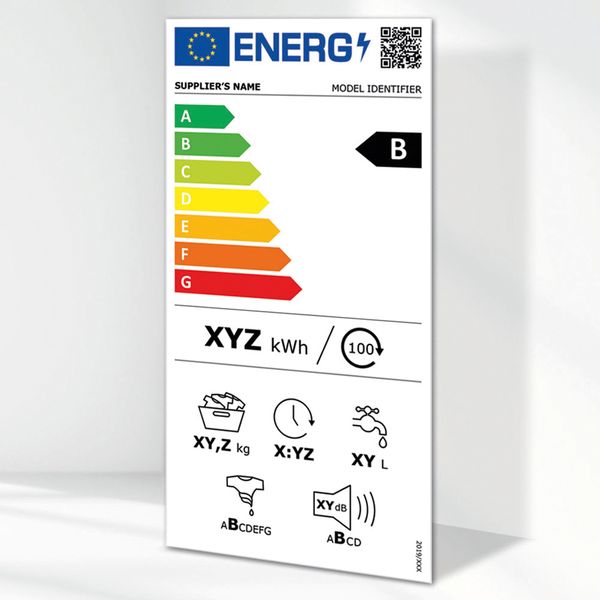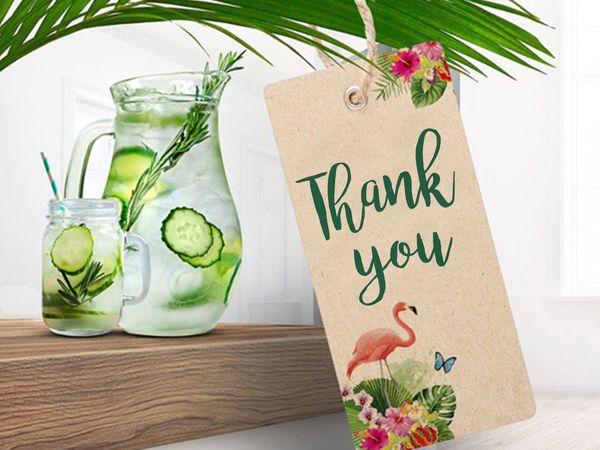Technological development over the past few years has resulted in a higher concentration of products that carry labels with a value of A+ or better. Consequently, the label has not been fulfilling its original function as an aid for making purchasing decisions as well as it formerly did. Other basic conditions like user behaviour have also changed. That’s why it’s time to adapt the existing Energy Label. The first home appliances to have the new label will be washing machines, washer-dryers, dishwashers, cooling appliances and wine coolers. As of March 1, 2021 these appliances must show the new label when sold in shops, online, etc. As the new label has to be added to these appliances already before this date, we would already like to provide you with some information on the future Energy Label.
The most significant change in the new Energy Labels is the elimination of the energy efficiency plus classes like, for example A+++. In the future, classification will be from A to G. New methods will also be used for measuring energy consumption and determining the label class. In addition, you will also be able to retrieve further product information directly via a QR code that is displayed on the Energy Label. The QR code forwards you to a database operated by the EU from 01.03.2021. This is where you can view and download data sheets for all appliances that require the new Energy Label. Access to the database is also possible via the Internet.
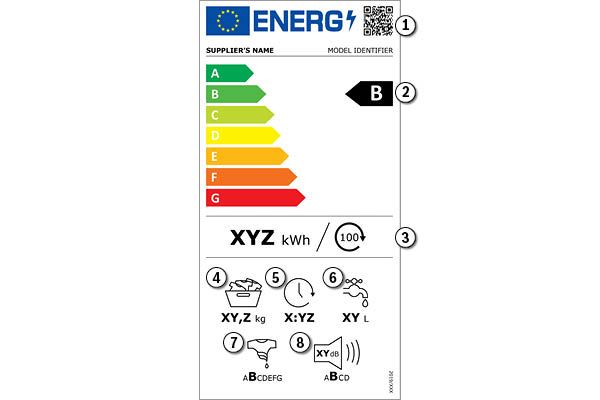
One of the major changes in the Energy Label for washing machines is the change in the test program to which all label values refer. Like for example the energy consumption which will be based on 100 wash cycles. The new “Eco 40-60”* program is suitable for cleaning normally soiled fabrics made of cotton, linen or mixed fibres which, based on their care symbol, are washable at 40°C or 60°C. The fabrics named may be combined in this wash cycle. The “Eco 40-60” program is the most efficient program in the combination “energy and water consumption”.
Legend:
1 QR code
2 Energy efficiency class**
3 Weighted energy consumption** in kWh/100 operating cycles (in Eco 40-60 program)
4 Maximum load capacity
5 Duration of “Eco 40-60” program
6 Weighted water consumption** in litres/operating cycle (in Eco 40-60 program)
7 Spin efficiency class**
8 Noise emissions during spin cycle expressed in dB(A) re 1 PW and noise emission class**
* Eco 40-60 In order to achieve optimal energy efficiency, an optimal washing temperature is defined for this programme. This temperature can’t be changed by the customer. The actual washing temperature is specified in the user manual and, depending on the load size, may deviate from the selected washing temperature for reasons of saving energy. Washing performance complies with legal requirements.
** Values apply to quarter, half and full loads.
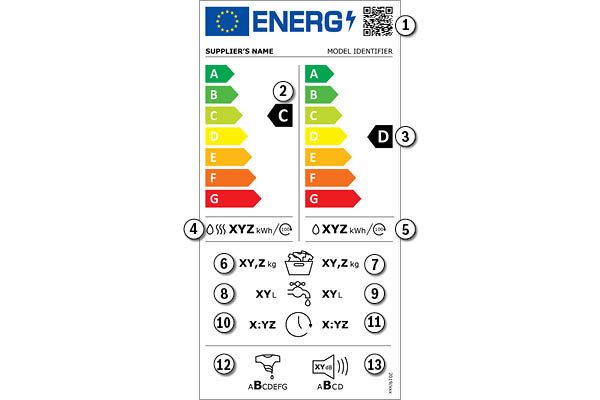
The current Energy Label for washer-dryers has not been revised since it was first introduced in 1996, which is why it still shows the original scale of A to G. Because washer-dryers are more frequently used just for washing, the label is divided into two parts. The left side of the label specifies the values for the complete “wash and dry” operating cycle. The right side of the label shows the values for the wash cycle alone. The values to be specified on this label for the wash cycle alone reflect the changes in mandatory information for the new washing machine label.
Legend:
1 QR code
2 Energy efficiency class* (complete operating cycle)
3 Energy efficiency class* (wash cycle)
4 Weighted energy consumption* in kWh/100 cycles (complete operating cycle**)
5 Weighted energy consumption* in kWh/100 cycles (wash cycle)
6 Maximum load capacity (complete operating cycle**)
7 Maximum load capacity (wash cycle)
8 Weighted water consumption* in litres/operating cycle (complete operating cycle**)
9 Weighted water consumption* in litres/operating cycle (wash cycle)
10 Program duration (complete operating cycle)
11 Duration of “Eco 40-60” program
12 Spin efficiency class*
13 Noise emissions during spin cycle expressed in dB(A) re 1 PW and noise emission class
* Values apply to washing quarter, half and full load. While washing and drying to half and full load.
** Wash and dry
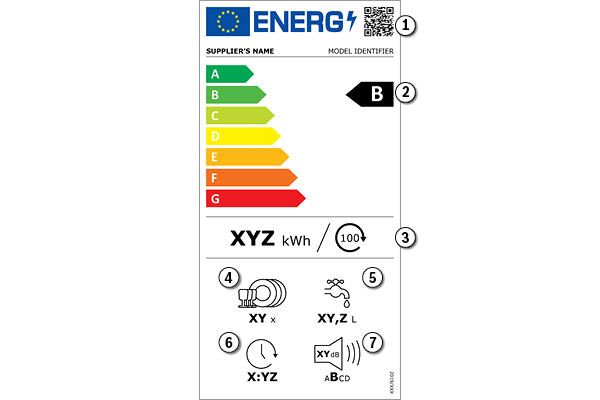
The energy efficiency class for dishwashers continues to be based on the “Eco” program. However, the test standard has been changed. For example, cups, pots, and plastic utensils will be used to determine cleaning and drying performance to better reflect actual usage behaviour. What is new is the specification of the duration of the Eco program. This program is especially eco-friendly, is ideal for normally soiled dishes and is the most efficient program in the combination “energy and water consumption”. As with washing machines and washer-dryers, energy consumption will be based on 100 cleaning cycles.
Legend:
1 QR code
2 Energy efficiency class
3 Energy consumption in kWh/100 operating cycles (in Eco program)
4 Number of standard place settings for the Eco program
5 Water consumption in litres/operating cycle (in Eco program)
6 Duration of the “Eco” program
7 Noise emissions expressed in dB(A) re 1 PW and noise emission class
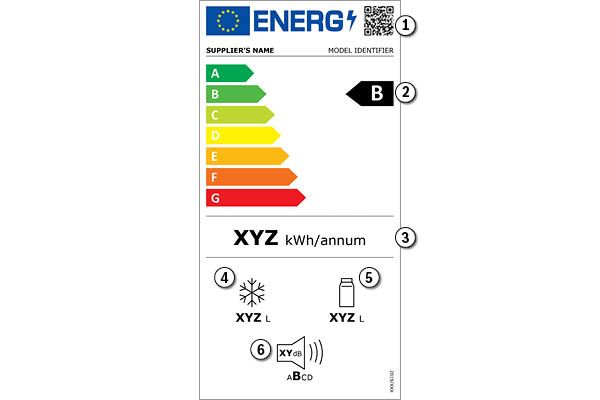
The procedure for determining the energy class is now more comprehensive. It takes into account the type of appliance, its operating principle, the room temperature, and the number and size of storage compartments. The rest of the elements on the new Energy Label basically remain the same. Energy consumption continues to be specified in kWh as annual consumption (“annum”). The label also provides information on the total volume of all refrigerator compartments and all freezer compartments, if any, and on noise emissions and the noise emission class.
Legend:
1 QR code
2 Energy efficiency class
3 Energy consumption in kWh/year (measured under new standard conditions)
4 Total volume of all freezer compartments
5 Total volume of all refrigerator compartments
6 Noise emissions expressed in dB(A) re 1 PW and noise emission class
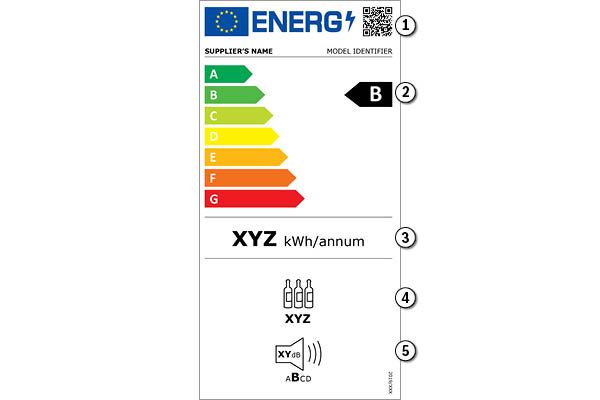
As with the other labels, the scale of energy efficiency classes is also changing for the label for wine coolers. Furthermore, a QR code and the noise emission classes are also given here. As before, the annual energy consumption and the number of standard wine bottles to be stored are still shown.
Legend:
1 QR code
2 Energy efficiency class
3 Energy consumption in kWh/year (measured under new standard conditions)
4 Number of standard wine bottles that can be stored
5 Noise emissions expressed in dB(A) re 1 PW and noise emission class
